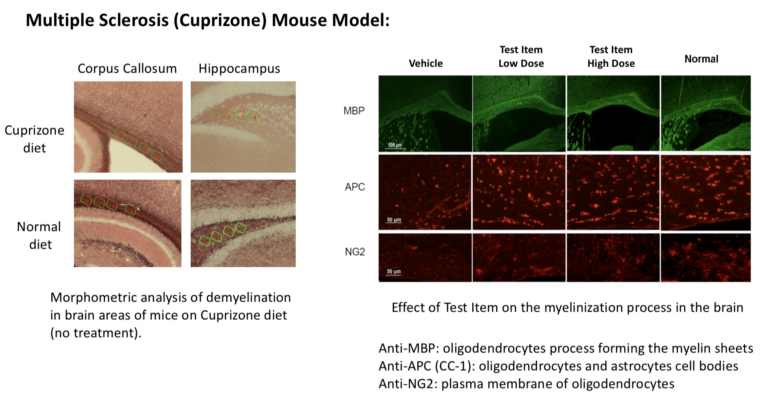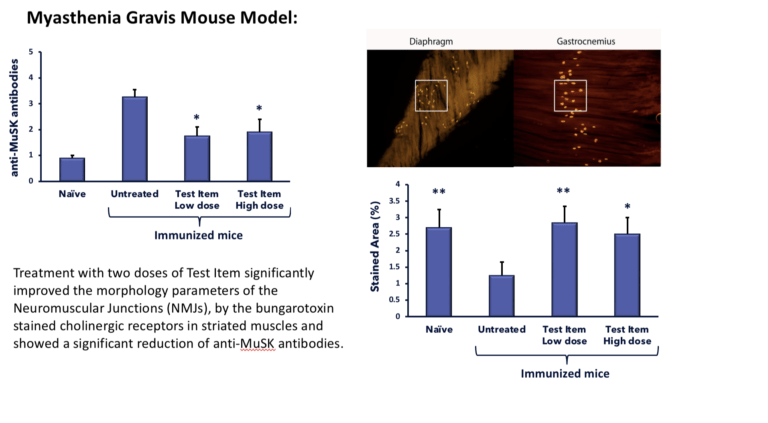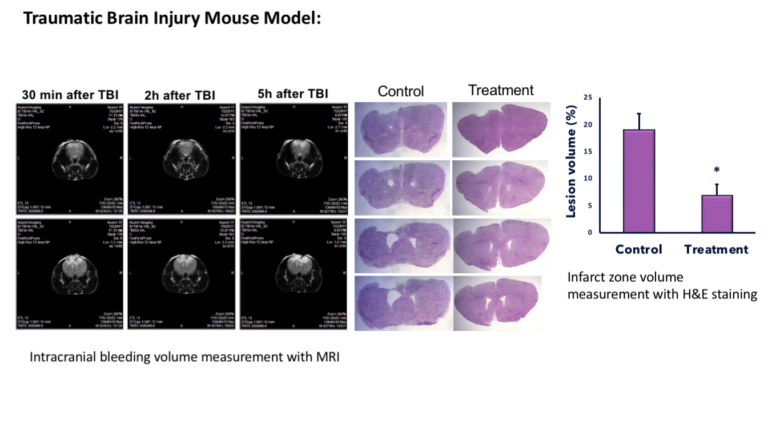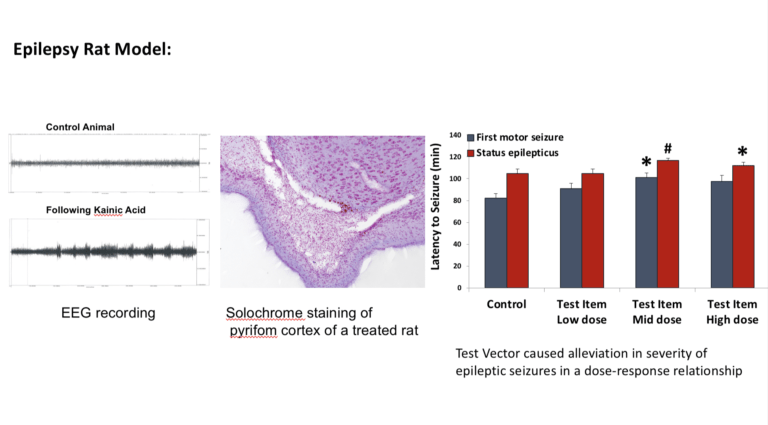Neurological Disorder Models
Neurological disabilities include a wide range of disorders such as, epilepsy, learning disabilities, neuromuscular disorders, autism, ADD, brain tumors, neurodegenerative diseases, traumatic brain injury, and stroke. The discovery of new therapies for neurological disorders is predicated on the use of animal models, both to identify new therapeutic targets and to perform preclinical trials of drugs before using them in patients. In both cases, the challenge is to develop models that recapitulate the disorder and to use follow up techniques that allow access to disease progression or recovery in a way that will be predictive for the following clinical studies.
The accession can be on behavioral or cellular level. Examples of behavioral level tests are open field, neurological severity score, novel object recognition test, and more. On the cellular level, we can perform in-person scanning such as IVIS or MRI or post-mortem staining using specific markers of neurogenesis, differentiation and trafficking.
Our services support an array of therapeutic disciplines

Cell & Gene based Therapy

Biological therapy

Cannabis based therapy

Microbiome

Pharmaceuticals

Medical devices

Nutraceuticals
Neurological Disorder Models
- Models available: 6-OHDA, MPTP, Rotenone, LPS aged mice induced dopamine degeneration.
- Species available: Mouse, Rat.
- Standard assessments: Body weight, clinical signs, rota-rod, open field, Morris water maze, object recognition test, social recognition test, passive avoidance test, eight-arm maze, beam walking test, cylinder test, stepping test, elevated plus maze, histology.
- Additional assessments: Micro-dialysis, catecholamine and indoleamine (IHC) tissue content measurements
- Models available: Permanent and Transient models (middle cerebral artery occlusions- MCAO & embolic models).
- Species available: Rat, Rabbit.
- Standard assessments: Body weight, clinical signs, neurological score, histology, infarct size measurement, brain hemorrhage and edema assessment.
- Additional assessments: Cognitive tests – water maze, stepping tests and forelimb , staircase tests, grip strength tests, social recognition tests, object recognition tests, body swing tests and forelimb placement, limb use tests, body postural balance tests and sensory tests (corneal, startle and pina reflexes).
- Models available: Chronic Cerebral Hypoperfusion.
- Species available: Rat.
- Standard assessments: Body weight, clinical signs, Morris water maze, object recognition test, social recognition test, open field, passive avoidance test.
- Models available: Pilocarpine, PTZ, Kainic acid.
- Species available: Rat.
- Standard assessments: Body weight, clinical signs, seizure score – epileptic clinical scoring.
- Additional assessments: Radial arm maze, Morris water maze, histology, IHs, PCR.
- Models available: MuSK or AchR induced EAMG.
- Species available: Mouse.
- Standard assessments: Body weight, clinical signs, grip strength, antibody levels (ELISA), histology, bungarotoxin staining.
- Additional assessments: EMG.
- Models available: MOG & pertussis toxin induced EAE, chronic & remission relapse models.
- Species available: Mouse.
- Standard assessments: Body weight, clinical signs, neurological score, histology (including myelin staining).
- Models available: Chemical induced, social – environmental induced.
- Species available: Mouse, Rat.
- Standard assessments: Body weight, clinical signs, force swim test, tail suspension, open field, elevated maze, Y maze.
- Species available: Mouse.
- Standard assessments: Sleeping test – latency to sleep and sleeping time, open field test, loss of righting reflex (LORR), elevated plus maze test
- Models available: Binge alcohol consumption.
- Species available: Mouse.
- Standard assessments: Clinical parameters, breathing, posture, abnormal behavior, alcohol consumption, open-field test have been established. Also possible are the Morris water maze, object recognition test, social recognition test, passive avoidance test, and histology.
- Models available: Phencyclidine (PCP)-induced Schizophrenia.
- Species available: Mouse.
- Standard assessments: Object Recognition Test, social recognition test, spontaneous open field activity, elevated plus maze test, self-grooming test, pre-pulse inhibition test.
- Models available: Black and Tan Brachyury (BTBR).
- Species available: Mouse.
- Standard assessments: Social recognition test (3-chambered social approach), spontaneous open field activity, elevated plus maze test, self-grooming test.
CNS\PNS:
- Models available: Spinal Nerve Ligation (Chung Model), Sciatic Nerve Ligation (CCI/Bennet model), Sciatic Nerve Inflammation (Neuritis).
- Species available: Rat.
- Standard assessments: Body weight, clinical signs, Von Frey, hot plate\ cold plate.
- Additional assessments: Cytokine levels (ELISA).
- Models available: Formalin/Capsaicin/Carrageenan.
- Species available: Rat.
- Standard assessments: Body weight, clinical signs, Von Frey, hot plate\ cold plate, erythema & edema, paw measurement, ankle measurements.
- Additional assessments: Cytokine levels (ELISA), histology (IHC).
- Models available: CFA, Carrageenan.
- Species available: Rat.
- Standard assessments: Body weight, clinical signs, Von Frey, hot plate\ cold plate, erythema & edema, paw measurement, ankle measurements.
- Additional assessments: Cytokine levels (ELISA) histology (IHC).
- Species available: Rat.
- Standard assessments: Body weight, clinical signs, Von Frey, histology (IHC).
- Models available: Hernia, Laceration (Laparoscopic approach, Laparotomy).
- Species available: Pig.
- Standard assessments: Body weight, clinical signs, histology, size assessment histology (IHC).
- Species available: Pig.
- Standard assessments: Body weight, clinical signs, histology, CSF pressure measurement.
- Models available: Cytoscopic approach.
- Species available: Pig.
- Standard assessments: Body weight, clinical signs, bioanalysis, erythema & edema, histology.
- Models available: Controlled Cortical Impact (CCI).
- Species available: Mouse.
- Standard assessments: Body weight, clinical signs, neurological score, object recognition test, open field, histology, infarct size measurement.
- Additional assessments: BBB integrity, immunostaining.
Research outcomes - examples






